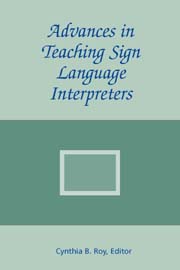Cynthia B. Roy, Editor
Foreword by Franz Pöchhacker
|
View the table of contents. View the list of contributors. Read the foreword. Read the introduction. Read an excerpt. Read a review. |
$63.25s print edition $63.25 e-book |
Interpreter Education, Volume 2
From Interpreting, International Journal of Research and Practice in Interpreting, cont’d.
The telephone is a cultural feature of the hearing world based on sound, of which the d/Deaf are deprived. Telephone interpreting is the topic covered in the last contribution, where Kyra Pollitt and Claire Haddon (with the interpreting team of the University of Central Lancashire, UK) explain that modern telecommunications such as faxes, c-mails, telemessaging, and text-phone relay services enable both deaf and hearing people to communicate directly but that they are not available to all. In order to arrange a mortgage, or ask for a money transfer, it may be quicker for a deaf person to communicate via phone through an interpreter. Their paper focuses on transactional phone calls (Cheepen 2000). A deaf person needs an interpreter who is present or visible via a video screen, but the third person involved has no video and expects to proceed as in normal ‘talk’ only through sound. Therefore, interpreters have to deal with cross-cultural implications which render telephone interpreting a very complex skill that is rarely taught. The authors describe in detail classroom retraining activities for people with prior experience in telephone interpreting. Role play is introduced with the focus on conventionalized aspects: openings, confirmation and closings. An important cultural aspect is emphasized: the feeling of disempowerment by the deaf participant. The interpreter must compensate for this through appropriate strategies but not act as though the hearing and the deaf person were equal in interactional terms as this would “negate Deaf identities and Deaf cultures by attempting to assimilate them to the values and norms of spoken-language cultures” (p. 201).
In conclusion, the pedagogy of language mediation, be it spoken or signed, is always of great interest, especially if the practical side of teaching is highlighted, as in this volume. Cynthia Roy’s collection of papers offers detailed insights into innovative classroom practices with an emphasis on rendering the learning environment as realistic as possible. Although there is no apparent logical progression or thematic grouping of topics, this volume succeeds in providing innovative and useful suggestions and practical guidance in teaching various aspects of sign language interpreting based on theoretical foundations which will certainly enable readers to enrich their classroom activities. Each of the papers in this volume explores broad pedagogical experimentation, incorporates cross-cultural issues or focuses on particular innovative strategies useful for educators in the field of sign language interpreter training, adding up to a welcome addition to the growing literature in interpreting studies.
Cynthia B. Roy is a retired professor in the Department of Interpretation and Translation at Gallaudet University, where she directed the BA program and the PhD program. She is also a nationally certified American Sign Language–English interpreter specializing in community interpreting.
Print Edition: ISBN 978-1-56368-320-6, 6 x 9 casebound, 224 pages, tables, figures, references, index
$63.25s
E-Book: ISBN 978-1-56368-391-6
$63.25
To order by mail, print our Order Form or call:TEL 1-800-621-2736; (773) 568-1550 8 am - 5 pm CST
TTY 1-888-630-9347
FAX 1-800-621-8476; (773) 660-2235
